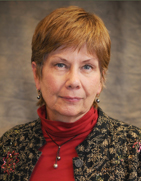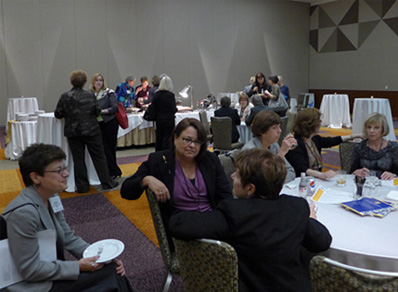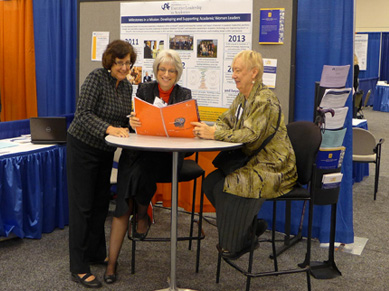Message from the Director - April 2013

Diane Magrane
Director of Executive Leadership Programs
Growing Our Community — It Takes a Village of ELUMs at Home
This last of three columns about how alumnae can engage in ELAM activities describes roles that require no additional travel to ELAM sessions. It is about the important roles that alumnae can play in recruitment and support of fellows in their own institutions and professional societies. It is about how we collectively make organizational contributions as leaders at home. You and your organization are the fundamental elements in the key culture changes that will lead to gender equity in leadership in academic medicine, dentistry and public health. How you conduct your business, how you "lift others as you climb," how you influence your administrative executives to make inclusive, progressive decisions, all contribute to the mission of ELAM to increase the numbers and impact of women leaders.
Three approaches in particular are important in supporting ELAM's mission: joint publicity that gives you and ELAM local and national visibility, hosting receptions that showcase your school and your ELUMs at national meetings, and actively reaching out and mentoring potential fellows, and especially your faculty, during their fellowship year.
We have several recent examples of how news stories that are announcing ELUM successes have recognized ELAM.
Visibility may be the key ingredient in sustaining ELAM's reputation and bolstering yours. Every other week in the ELAM Edge we list achievements of fellows and alumnae. These include new positions, initiatives that you undertake in your leadership role, and awards. The ones that give us the most "kick" are those in which the press release identifies you as having participated in ELAM, or the initiative as having begun as an ELAM project. Long ago, Page Morahan embedded a lesson in "graceful self-promotion [PDF]" into the ELAM fellowship curriculum. It showed up as invitations to share your achievements and new positions with your class during opening sessions and on a Blackboard site (WebCT for those of us that go wa-a-ay back). Learn how to mention ELAM in publications [PDF], and please contact us at any time for suggestions of language that you can send to your public relations office to accompany the description of your award or event. Let them know where you would like it to be shared (local paper, professional societies, e.g.). I once asked that a press release go to my hometown paper, the Ottumwa Courier. As a result, my parents were the toast of the town for several weeks and had a clipping to carry to the grocery store for bragging. Don't kid yourself; the dean does something similar as s/he travels. That PR is good for expanding your network and bringing pride to your mentors, and the link to ELAM shows that we are meeting our mission to advance women in numbers and impact in academic medicine, dentistry and public health.

ELUMs gathered at the 2012 AAMC ELAM fellows and alumnae tea in San Francisco.
Hosting an ELUM event when a national meeting is held in your home town is another wonderful way to bring attention to your institution and the network of ELUMs around you. ELAM staff routinely attend events in which we can expect several alumnae to gather. The past two years' AAMC meetings (Denver in 2011 and San Francisco in 2012) were rousing successes, with over 80 alumnae and friends attending each. What made it even more special was the attention given by the ELUMs to working with Olivia Lee and Roz Richman to organize an event with good food, great connections, and a highlighting of local ELUM achievements. If you have a meeting with a large number of ELUMs expected to attend and would like to host a reception, please let us know.
Mentoring ELAM fellows has many dimensions—advising colleagues about approaches to seizing opportunity and managing challenges (or better yet, making challenges into opportunities!) and encouraging them to stretch into roles that match talents and capabilities that they may not yet be able to see. Scholars of women's advancement have called this latter function "sponsorship" and cite it as critical to leadership development. Within ELAM, these functions begin with tapping someone on the shoulder to acknowledge her leadership potential, supporting her development as an institutional leader who qualifies and would benefit from ELAM, helping her pull together a strong application, and then standing back but watching closely to determine whether a shared cup of coffee in the spring will be one of celebration and preparation or consolation and more preparation. Once accepted, fellows benefit from a small touch of reality about the intensity of ELAM and a large helping of advice about how to use the year's experience to maximum benefit. This is especially true for identifying a good Institutional Action Project that captures her passions for change and the interests of senior executive mentors.
Four steps lead to a successful ELAM application.
- The process begins with a simple question: "Have you ever considered applying to ELAM?" and is followed by sharing your own story of considering, applying, and participating. Those of you who had the experience of not being accepted the first time may have even more to offer.
- The second step is to do a check of her experience and institutional support against the criteria for strong applications, recommendations, and nominations listed on the ELAM applications site. Be sure to review all three sets of questions — for the applicant, nominator, and recommender — for a full understanding of what the selection committee will be discussing. What you will recall when you review this site is how important the institutional mentoring is to the application. ELAM is not just about the individual; it is about the mutual relationships that benefit the fellow as she contributes to an institution that can foster women leaders!
- The third step varies by institution. Some of you have formed a selection committee that reviews applications from women faculty and recommends one or two candidates to the dean /CEO for nomination. In these cases, it is important for all committee members to be aware of selection criteria (and it behooves your dean or one of you to volunteer for the admissions committee). In institutions without an internal selection process, the third step is for the applicant to have a conversation with the dean of the school (whether the dean drafts, edits, or signs the nomination essays, this conversation is critical). This conversation actually has the potential to propel your protégé forward in leadership even before the ELAM application arrives in our database. What a gift for the dean to have a conversation in which a talented faculty member identifies herself as interested in a leadership pathway, and in doing so strategically through ELAM participation. This usually is an investment that is hard to turn down!
- The fourth step begins from receipt of one of three letters from ELAM: one begins with congratulations and asks for confirmation of participation, one opens with regrets and hope as one of two to three alternates for the coming year, and the third begins with regrets and offers a telephone conversation about the application and continuing leadership mentoring. None of these letters closes off opportunities for institutional leadership. Your role as mentor kicks in here to help the candidate understand this. If she is accepted, make sure she reads carefully through the time commitments and assignments for the year (we send an approximate calendar), matches them to her calendar, and makes contact to follow up with her nominator. If she is an alternate or not accepted for the coming class, walk through the mentoring plan for institutional leadership as described in the application, get her to set up an appointment to talk to the director, and then make contact with her nominator to continue the leadership conversations. Often, the plans for project development and institutional leadership opportunities can continue despite not being able to participate in ELAM. Such a pathway only strengthens a subsequent application.

Barbara Schindler (ELAM '97), Rosalyn Richman, and Page Morahan meet at the ELAM booth at the 2012 AAMC meeting.
The joy with a fellow begins with internal and external press releases to announce her joining the community of ELAM (see the section above for more about press releases and how important they are). In a few weeks, you will see her excitement as the first easy assignments arrive in her inbox and on Blackboard. Hopefully, you will be nearby with encouragement as the assignments begin to become more intense, and her eyes begin to roll as her world begins to spin, not only ELAM with work, but also from being "noticed" by leaders who now discover the overnight success that has been brewing for 10 to 15 years. And of course, you will be with her for strategic advice during the year and for alumnae events, encouraging her to join the network of mentors and sponsors for others following in her path.
Perhaps it need not be said, but I also hope you will reach out in the same fashion to welcome our colleagues from engineering and other STEM fields. The inaugural class of ELATE fellows has no large alumnae community beyond ELAM, and many of us are from the same institution or city. For those who are considering ELATE and for the leaders who can support them, you will be a tremendous resource. I hope you will encourage them to discuss ELATE with their deans and provosts.
With the closing of this series of three columns describing volunteer roles to support ELAM, you have a full menu of valuable ways to contribute to ELAM. You can:
There may be others—after all, we have a very creative community of leaders, and many of these roles have been created in response to alumnae suggestions. Although we cannot promise your first choice the first time you volunteer, as you can see we need to create a very, very large village of support for ourselves and our fellows. Let us know your interests and ideas. If you wish to participate and you don't offer, then we all miss an opportunity. And if "opportunity knocks," I hope you will answer!
ELAM is a core program of the Institute for Women's Health and Leadership at Drexel University College of Medicine, Philadelphia, Pa. The Institute continues the legacy of advancing women in medicine that began in 1850 with the founding of the Female Medical College of Pennsylvania, the nation's first women's medical school and a predecessor of today's Drexel University College of Medicine.